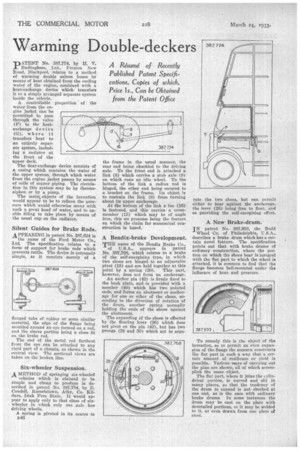Warming Double-deckers
Page 60

If you've noticed an error in this article please click here to report it so we can fix it.
A Resume' of Recently Published Patent Specifications, Copies of which, Price Is., Can be Obtained from the Patent Office
Mikl■ ATENT No. 387,774, by II. V.
Burlingham, Ltd., Preston New Road, Blackpool, relates to a method of warming double saloon buses by means of heat obtained from the cooling water of the engine, combined with a heat-exchange device which transfers it to a simply arranged separate system inside the vehicle.
A controllable proportion of the water from the engine jacket can be permitted to pass through the valve (10) to the beatexchange device (G), where it transfers heat to an entirely separate system, includ-I lug a radiator at the front of the upper deck.
The heat-exchange device consists of a casing which contains the water of the upper system, through which water from the engine jacket passes by means of coils of copper piping. The circulation in this system may be by thermoSiphon or by a pump. The main; objects of the invention -would appear to be to relieve the pressure which would otherwise occur with such a great head of water, and to enable filling to take place by means of the usual cap on the radiator.
Silent Guides for Brake Rods.
APPEARING in patent No. 387,624 is the name of the Ford Motor Co., Ltd. The specification relates to a form of support for brake rods which prevents rattle. The device is extremely simple, as it consists merely of a flanged tube of rubber or some similar material, the edge of the flange being moulded around an eye formed on a rod, and the sleeve portion being a close fit on the brake rod.
The end of the metal rod farthest from the eye can be attached to any rigid part of a chassis, as shown in the central view. The sectional views are taken on the broken line.
Six-wheeler Suspension. A METHOD of springing six-wheeled vehicles which is claimed to be simple and cheap to produce is described in patent No. 387,754, by E. Conde% Russelstown, Athy, Co. Kildare, Irish Free State. It would appear to apply only to that class of sixwheeler in vihich only one .axle has driving wheels.
A spring is pivoted in its centre to 1346 the frame in the usual manner, the rear end being shackled to the driving axle. To the frent end is attached a link (8) which carries a stub axle (9) On which runs an idle wheel. To the bottom of the link a radius rod is hinged, the other end being secured to a. bracket on the frame. Its object is to restrain the link (8) from turning about its upper anchorage. At the bottom of the link a toe (16) is fastened, and this carries a crossmember (15) which may be of angle iron, this we presume being the feature on which the claim for economical construction is based.
A Bendix-brake Development.
THE name of the Bendix Brake Co., of U.S.A., appears in patent No. 387,768, which relates to a brake of the self-energizing type, in which two shoes are hinged to an adjustable pivot (18) and -are held together at this point by a spring (20). This part, however, does not form an anchorage. An anchor pin (42) is firmly fixed to the back plate, and is provided with a member (40) which has two pointed ends, and forms an abutment or anchorage for one or other of the shoes, according to the direction of rotation of the drum, another spring normally holding the ends of the shoes against the abutments.
The expanding of the shoes is effected by the floating lever (26) which does not pivot on the pin (42), but has two prongs (28 and 30) which act to sepa
pate the two shoes, but can permit either to bear against the anchorage, the lever (26) being free to float, and so providing the self-energizing effect.
A New Brake-drum.
IN patent No. 387,933, the Budd Wheel Co. of Philadelphia, U.S.A., describes a brake drum which has a certain novel feature. The specification points out that with brake drums of ordinary construction, where the portion on which the Aloes bear is integral with the flat part to which the wheel is attached, it is common to find that the flange becomes bell-mounted under the influence of heat' and pressure.
To remedy this is the object of the invention, so to permit an even expansion of the flange the concern constructs The fiat part in such a way that a certain amount of resilience or yield is possible. Various ways of carrying out the plan are shown, all of which accomplish the same object. The flat part, where it joins the cylindrical portion, is curved and slit in . many places, so that the tendency of the drum to expand is not checked at one end, as is the case with ordinary brake drums. In some instances the drum may be cast on the plate with dovetailed portions, or it may be welded to it, or even drawn from one plate of steel.




























































































